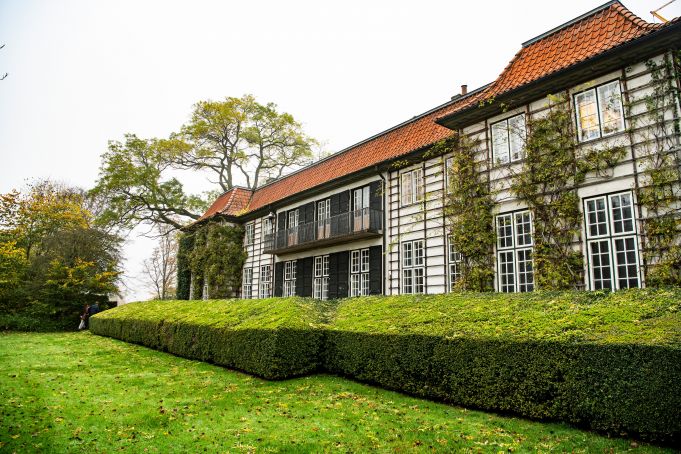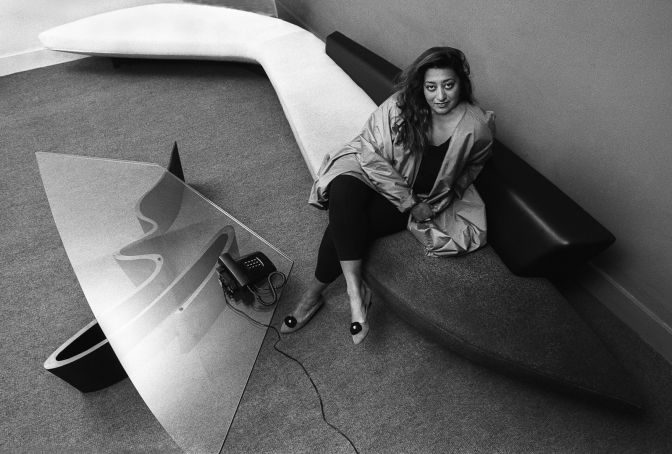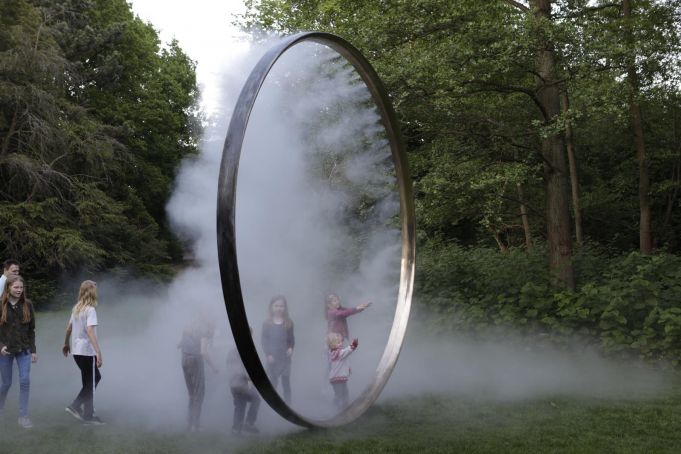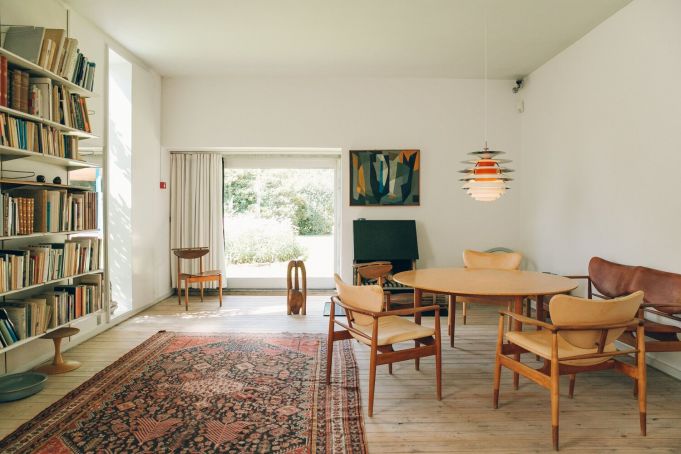Visiting the Ordrupgaard museum by Zaha Hadid
The Ordrupgaard museum is famous for its Art Playground, and it’s building designed by the world- renowned architect Zaha Hadid.
Ordrupgaard Art Museum is located near Jægersborg Dyrehave, a suburb north of Copenhagen, Denmark. It houses one of the largest collections of Danish and French art from the 19th and early 20th centuries in Northern Europe.
History of the Ordrupgaard

Originally built in the early post-war period in 1918 as an estate, by the founder of the Dansk Folkeforsikringsanstalt (Popular Insurance Company) Wilhelm Hansen and his wife Henny, it was designed as a three-wing neoclassical style country residence. An avid collector, the property was enlarged to showcase the owner’s French and Danish Impressionist paintings.
Also read: Best museums in Copenhagen
Unfortunately, in 1922 Wilhelm Hansen suffered a huge financial loss and, in order to make up for it, he was forced to sell half of his French collection. He auctioned eighty- two works, including pieces by Cézanne, Gauguin and Manet. Once the crisis had passed, the collector resumed buying works the following year, but was unable to get back many of those sold.
Hansen died in 1936 and his wife continued to live alone in the Ordrupgaard until she too passed, in 1951, and bequeathed the entire collection, the building and the park, to the state of Denmark. Just two years later, the museum was opened to the public as a state museum. The museum has been open since 1953.
The Hansen Collection
Ordrupgaard has one of the largest collections of paintings from the Danish Golden Age (1892-1916), as well as French Impressionism, purchased by Hansen in the period between 1916 and 1918, on the advice of Théodore Duret (a French journalist and art critic who is still considered a champion of impressionism). Many paintings were acquired from noted Parisian art dealer Alphonse Kann. Back at Ordrupgaard, Hansen's purchases were so numerous that he added a wing to the construction of his villa. Hansen belonged to a group of art lovers and patrons who formed the largest collections of their time, sometimes to the point of ruin, as in the cases of Samuel Courtauld in England, or the American Louisine Havemeyer.
Also read: Visiting Helsingør and Kronborg Castle: what to see and what to do
Zaha Hadid's extension
The original early 20th-century structure was extended in 2005 with the glass and black lava concrete wing designed by Zaha Hadid. The expansion doubled the Ordrupgaard space, adding 1,150 square meters for exhibition facilities, a multipurpose room, and the café.

Black lava cement is a special material, which creates a variable surface color, depending on weather and wind conditions, with shades ranging from matte gray to glossy black. The interior space is a single, fluid space in which the division between galleries, corridors, floors and ceilings is hardly noticeable.
Zaha Hadid's entire structure follows the movement of the land, and so the floors and ceilings rise and fall along the crest of the hill on which it stands. The glass walls, on the other hand, have the dual function of giving natural light to the interior spaces, but also of connecting them more with the green space that surrounds the structure.
Also read: Italy celebrates 10 years of MAXXI with a stamp
As in many other projects designed by Hadid, the architect worked to decode and interpret the environment. Previous studies of early terrain found in Ordrupgaard Park led to an idea of a sophisticated modeled figure almost "suspended" above the hilly terrain. The structure has been compared to a beached whale and a spaceship. Regardless of these associations, it is a building that folds neatly into the topography of the landscape.
The new entrance to the museum is through a courtyard that physically separates the new building from the former French Gallery building.
Also read: All you need to know about visiting the Louisiana Museum in Denmark
Inside, the building was opened as a "fluid space", so detecting the transition between the galleries and corridors is difficult. Rooms are constantly engaging the curves of the earth, with the roof rising and falling. A long sloping ramp divides temporary and permanent exhibitions, then leads to the multipurpose room and cafeteria overlooking the garden. A bright white café at one end of the curved building, right in the garden, creates the feeling of an ultra-modern and elegant conservatory. In many places, the walls are steep and irregular, exploring a variety of twisted angles. The terraces are designed to connect with existing gardens of the original villa, allowing visitors a new visual connection.
How to get to there
The most practical way to reach Odrupgaard is by car. Upon entering the gate of the museum, there is a small parking lot where to leave the car.
Also read: Shopping in Copenhagen
However, you can also use public transportation from Copenhagen. With a couple of buses and a few minutes walk you can reach the Ordrupgaard in three quarters of an hour from the city. Take the bus 169, 179 or 185 to Femvejen station. It is a 20 minute walk from Femvejen to the museum. If you prefer to take the train, depart from the the central station and ake the S-train to Klampenborg or Lyngby Station, and then take the 388 to Vilvordevej. It is a 2-minute walk to the museum.
Collections of the Ordrupgaard
Hansen founded his collection with works from the Danish Golden Age, with pieces ranging from the 19th to the early 20th century, from about 1892 to 1916. Within it are works by such notable Danish artists as Wilhelm Marstrand, Christoffer Wilhelm Eckersberg, Johan Thomas Lundbye, Christen Købke and PC Skovgaard. Later, Hansen, who was also strongly interested in contemporary art, purchased numerous other works by Vilhelm Hammershøi, Fritz Syberg, Theodor Philipsen, LA Ring, Fynbo Painters Johannes Larsen and Peter Hansen.
Also read: All you need to know about the Egeskov Castle
It wasn't until the First World War that Hansen began to be curious about French art, and he began acquiring pieces from France’s most renowned artists. Between 1916 and 1918 he bought paintings, pastels, sculptures and drawings from names like Alfred Sisley, Claude Monet, August Renoir, and Camille Pissaro. Although his strongest interest was in French Impressionism, he also bought works from earlier and later periods. So when visiting the Ordrupgaard, you can come across Delacroix, Rousseau, Courbet, as well as Manet and Gauguin.
The Ordrupgaard Art Playground

This began as a three-year project in which internationally known artists created site-specific works. Each summer the park is updated with contributions and works, aimed at creating a contemporary open- air museum.
The works displayed in the Ordrupgaard Art Playground are often closely related to the environment, through the use of natural raw materials, or they reflect elements such as water and light. The art playground opened in 2013 and is freely accessible to visitors even during times when parts of the museum are under contstruction.
The first work to be installed in the playground was Jeppe Hein's Semicircular Mirror Labyrinth II, which is a labyrinth constructed of two-meter-high reflective steel plates that form a path into which you can enter.
In 2015, among other works, Confiteor by Henry Kroktasis was added. The artist is known for reusing abandoned objects and giving them new life. In this particular piece, the structure, raised from the ground by a pole, is an ambiguous space halfway between a pavilion, a tool shed and a confessional. The space can only be seen from the outside, although you are allowed to open the doors and peek inside.
Also read: Man Meets the Sea: The giant statues of Esbjerg
The theme of 2016’s addition was fun, shown in Olafur Eliasson's Vær i vejret (Weather the weather): a large circle planted on the ground from which a massive amount of vaporized water spills out, drawing especially younger visitors. The large bronze ring covers the garden with a thick fog, which changes direction as the wind changes. The ring sprays powerful jets thanks to 36 nozzles that run along the entire circumference of the circle. Unfortunately, the work is not always in operation and you may only be able to see the structure when it is turned off.
In 2017, Art Playground added a large pine cone, the Pinecone Pavilion by Danish artist duo Randi and Katrine. The work is a four-and-a-half-foot tall pine cone, half-hidden among shrubs and underbrush, shaded by pine trees that will drop pine cones all around. The pine cone represents a decorative element of architecture, but also the symbol of knowledge and enlightenment. In addition, the pine cone was used as a decorative motif within Ordrupgaard, in furniture and stucco ornaments.
2018 was the year of American duo Doug and Mike Starn, who created a vertical bamboo maze: Geometry of Innocence, for their Big Bamboo series. Also belonging to this series is a work that was installed on the roof of the Metropolitan Museum of Art in New York for a full six months in 2010, which was the ninth most visited exhibition ever in the museum's history. Geometry of Innocence is a tall bamboo structure on which one can walk to the top, as well as the top of nearby trees. While exploring the 15 meter high bamboo structure, you will come across suspended bridges, relaxation areas where you can sit on benches equipped with cup holders.
These main works are flanked by others, scattered around the garden of the museum. You can find houses and cottages built in wood under - or at the height of - the trees, built during the period of activity of Ordrupgaard. Every year, new works are added and some of the previous ones are removed, so each visit is a new experience.
Also within the Ordrupgaard Art Playground is the Finn Juhl House, which was built by the furniture designer as a functionalist home. Designed in 1941 and 1942, Juhl lived in the home until 1989 and, following a donation, it was opened in 2008 as an additional part of the Ordrupgaard Art Museum.
Finn Juhl's House

Juhl was a Danish architect, interior designer, and industrialist, best known for his furniture design. He was one of the leading figures in the creation of "Danish design" in the 1940s.
The house at Ordupgard is an example of Juhl’s explorations as an architect and designer. He built the house in Ordrup Kratvænget in 1942 on the 1700 m² property, near the Ordrupgaard park. Thanks to a private donation, the house is now a permanent part of the Ordrupgaard.
Ordrupgaard Café
The recently remodeled café and restaurant is open Tuesday- Friday from 12:00pm- to 5:00pm, and 11:00am - 5:00pm on weekends.
Where is the Ordrupgaard Museum
Address: Vilvordevej 110, 2920 Charlottenlund, Denmark
Phone: +45 39 64 11 83
Webiste: ordrupgaard.dk
Top ph: tomtsya / Shutterstock.com
General Info
View on Map
Visiting the Ordrupgaard museum by Zaha Hadid
Ordrupgaard, Vilvordevej, Charlottenlund, Denmark








